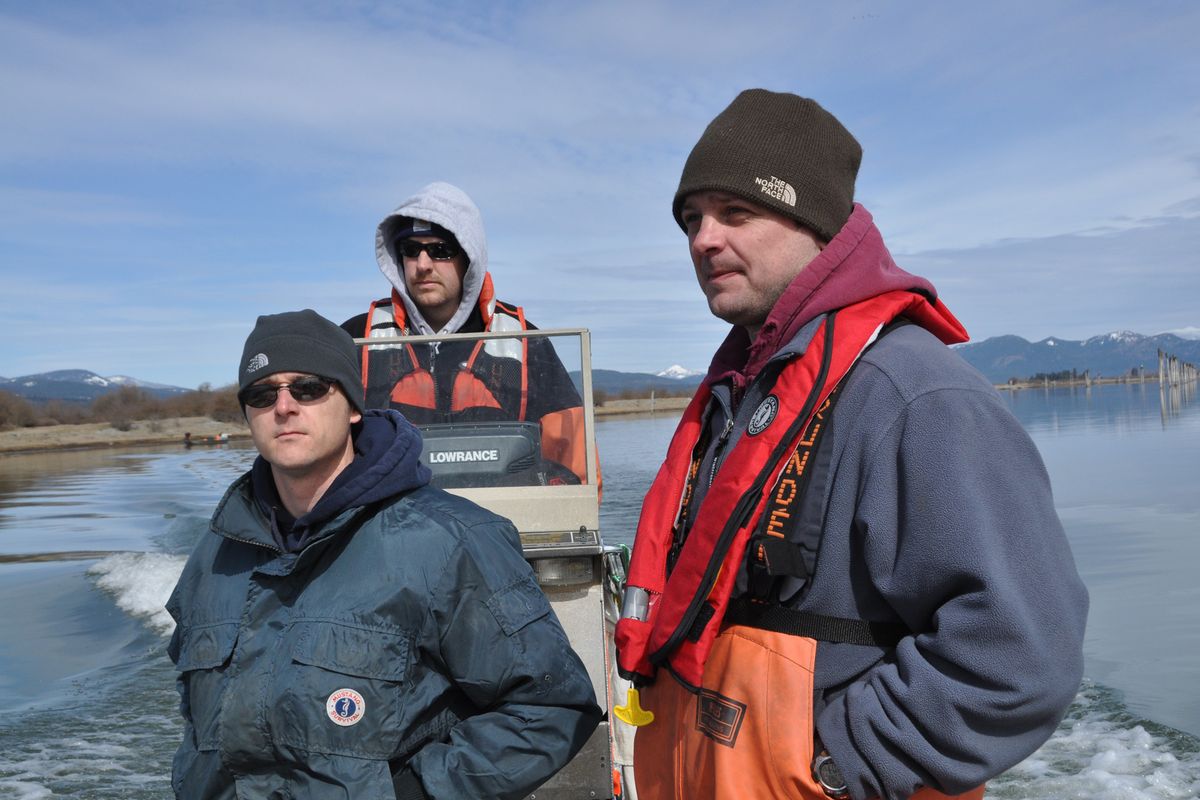Gillnets set to remove 5,700 northern pike from Pend Oreille River

The gillnets in the Pend Oreille River were catching as much attention as fish last week. Four workers in two boats were in their third week of 10- to 12-hour days devoted to hauling bucket loads of northern pike out of Box Canyon Reservoir. Although few anglers were on the river in the unpleasant spring conditions, every fisherman the workers passed had questions.
“What are you catching? How many? Why?”
I joined fish managers on the river Tuesday to ask these and other questions for an update on the operation targeting the invasive species – the first reproducing population of northern pike in Washington.
After years of research, the Washington Department of Fish and Wildlife and Kalispel Tribe have set a goal to remove at least 87 percent of the non-native pike from the Newport area downstream 55 miles to Box Canyon Dam this year.
By reducing the burgeoning numbers of pike in this river stretch, the state hopes to give remaining pike enough hunting room to keep them happy where they are.
“We know we can’t eradicate pike from the river,” said Bill Baker, WDFW district biologist. “But nobody wants them farther downstream into the Columbia. Pike could have a major impact on our investment in salmon and steelhead recovery.”
In the past decade, pike washing down from illegal introductions in Montana have found a Shangri-La in Box Canyon, with its riverside sloughs that provide ideal spawning rearing habitat for the voracious predators.
Spring runoff floods the sloughs, where the water quickly gets warmer than water in the river channel.
Workers have set 16 gillnets, mostly at the mouth of the sloughs, to intercept pike looking for warmer water to spawn.
“Spring is our best opportunity to target a lot of pike before they disperse more widely throughout the river,” said Jason Connor, head of the tribe’s pike research program.
The netting started in late March when ice still lined many of the sloughs. Dramatic river level fluctuations rendered the river brown with silt last week. Visibility was 2 inches. Angling was difficult. Even the nets were catching only about 10 pike apiece a day.
“We’ll do better when the river stabilizes a little and the water warms in the sloughs,” Connor said.
Vandals – curious or malicious – have been tampering with the nets at night.
“Some people have become attached to this pike fishery and they don’t see the big picture,” Baker said.
“We’ve heard from people who don’t like what we’re doing or don’t believe the numbers we report,” Connor said. “Every fish we take is recorded.”
At least four Washington laws prohibit tampering with nets, he said.
“All of these crimes are considered gross misdemeanors, require mandatory court appearance and can be quite costly,” he said.
The net vandals were quick to spread some of their observations by email. One report cited the nets full of dead perch.
But that’s not what I observed as Chuck Littlecrow tended a net with his co-worker, Nick Bean. The 10 pike in the net – most under 20 inches long – were dead or nearly dead. The average pike is running 3-4 pounds, Connor said, with a lot of yearlings from a big spawn prompted by last year’s high-water conditions.
A peamouth running about 15 inches long was dead.
But every one of the dozen or so bluegills Littlecrow removed from the net was alive and vigorously swam away when dropped to the water.
“The smaller fish just kind of hang up in the net and they don’t struggle,” Connor said. “They’re easy to remove and 90 to 95 percent of them swim away unharmed. The cold water helps with survival.”
So far, the tally from the nets is about 75 percent northern pike, he said. The other 25 percent of the take is a mix of the other 18 fish species found in the lake.
“The bycatch is pretty much insignificant,” Baker said. “That’s because of the net design, the mesh sizes and the placement.”
“Nets aren’t a catch-all,” Connor said. “They catch only a small fraction of the non-target species out there.”
In a letter to the editor published in The Spokesman-Review last week, an angler wrote that the fish managers had ruined the first good fishery the Pend Oreille River had produced, noting that he’s catching fewer fish and smaller-sized fish than he caught a few years ago.
Fish managers say the trend to smaller “hammer handle” fish is the natural progression in a booming pike population.
Population studies in previous years have harvested a total of about 2,000 northern pike of all size ranges, Connor said.
“In that time, the number of pike has grown despite our studies because they were reproducing every year,” Baker said.
To achieve the 87 percent population reduction in Box Canyon this spring, the state and tribe plan to kill about 5,700 pike, while encouraging anglers to catch more throughout the spring and summer.
“Our estimates are conservative,” Connor said, noting that creel surveys indicate anglers are likely to kill only about 300 pike this season.
At the end of April, the pike removal strategy will end and the nets will be positioned in a random pike index survey to estimate pike abundance. If the pike have been reduced sufficiently, the netting season will be over.
But if more than two pike a day are found in the nets scattered randomly around the river, the pike removal netting will resume.
“Several fishing contests are planned to encourage people to some out and catch pike,” Connor said. “You won’t be having 40-fish days if everything goes as planned, but there will still be pike to catch.”